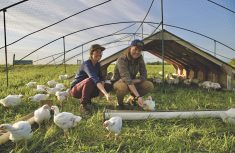In the early days of European settlement, churches played a pivotal role in rural Canada. In fact, says Rev. Dr. Cam Harder, an ordained Lutheran minister and theology professor at the University of Saskatchewan, churches were the key to the cultural life of a community.
The same was true in the East, where traditionally the church was more than a place of worship, agrees Dr. John Young, a United Church minister and professor at Queen’s University in Kingston, Ont. The church was often the only meeting place in town and was used not only for church functions but also as a meeting place for non-church groups.
Read Also

Employment Agreements Can Help Protect Your Farm
Entering into employment agreements with each of your farm employees should be at the top of every farm’s “to do” list, but caution must be exercised.
But now, those churches are under increasing threat.
It isn’t new. Rural depopulation has meant that many churches, once the hub of the local community, have closed, with the outlook made worse by the fact that between 1960 and 1975, church attendance dropped from 60 per cent to 30 per cent, according to University of Lethbridge sociology professor, Dr. Reginald Bibby in his e-book, A New Day — The Resilience and Restructuring of Religion in Canada.
The mainline Protestant churches — United, Lutheran, Presbyterian and Anglican — were the hardest hit, Bibby writes.
Yet Bibby’s research shows some other interesting trends. While the proportion of Canadians identifying as Roman Catholic has remained stable at 40 per cent for the past 70 years, the percentage of Canadians who are evangelical Christian (such as Baptist, Pentecostal, Mennonite, Nazarene and Alliance) has increased from eight to 11 per cent (with most of the increase taking place in the last 15 years) and the percentage of those of non-Christian faith (e.g. Muslim, Sikh, Hindu) has increased from three to eight per cent.
The biggest change, though, has been in the percentage of Canadians claiming “no religion,” which has jumped from one to 25 per cent.
Mainline Protestant churches also tend to have older congregations than the Roman Catholic and evangelical Christian churches.
Church attendance is determined by three factors: natural increase (births minus deaths), migration (to and from other groups) and finally performance (how well the church meets the needs of its members).
Before 1950, people would attend church out of obligation, explains Bibby, but today many will only attend if they feel they get value for their time spent.
Churches which work to identify and address the specific needs of their members are the most successful, says Young. “You have to meet people where they’re at,” he emphasizes.
- From the Grainews website: Your deepest needs
For example, many evangelical churches have seen their attendance increase because they have hired youth pastors and offer youth programming, says Young. They have been innovative and they have reached out to the community, he says.
While there has been a hollowing out of rural institutions with the closing of post offices, schools and local stores, in general rural churches have shown more resilience than their suburban or urban counterparts.
Those moving into rural areas tend to have a strong sense of community, explains Young. And those with deep family roots tend to value tradition, which means they are more likely to attend the church of their ancestors.
Despite the downward trend in church attendance, religion is definitely not dead in Canada, say Bibby. “What transpires in Canada as far as the “religion/no religion” balance will depend largely on the collective performance of its religious groups,” he writes.
Bibby encourages people to work together, to seek out like-minded individuals and to build bridges within the same denomination or other denominations with shared values.
Many churches in rural Canada are doing just that.
New Brunswick
In Plaster Rock, a village of about 1,100 in the woods of New Brunswick, the Anglican and United Church congregations are taking turns holding Sunday services. Each church has a half-time minister, says the United Church pastor, Amanda Longmoore.
“It’s going really well,” says Longmoore. “People are attending each week. There’s a new energy and it’s better for community outreach.” If things continue to go well, they will look at closing one of the two church buildings. “That will be hard,” admits Longmoore. “People are really attached to their buildings. People have to be ready, but if they are ready, you can do a lot.”
When the Loyalists settled the southern St. John River Valley in New Brunswick following the American Revolution, they built an Anglican Church every few miles along the river. With an aging and declining population, it was no longer sustainable to keep all of these churches open, explains Rev. Michael Caines, the current rector of the Anglican Church of the Resurrection in Grand Bay-Westfield.
A decade ago the seven small congregations were combined into one parish. The churches were deconsecrated and the proceeds from the sale of the church properties were used to build a new modern church, which was completed three years ago. “They took their time, collected pictures and made archives of the old churches,” explains Caines. Every stained glass window from the old churches was saved and hung in the centre of the new church to preserve the history. “There were hurt feelings and feelings of loss. It was rocky at times, as expected,” says Caines. But, he emphasizes, everyone was consulted and had a chance to say their opinions.
Ontario
In the tiny hamlet of Kinkora in southwestern Ontario the parishioners of St. Patrick’s Roman Catholic Church rallied to raise $2 million to restore their 1882 church and build a new parish hall. The money was raised through fundraisers such as galas, auctions, recycling drives, bake sales and garage sales, says Francis Ryan, the church caretaker.
Not only did the congregation of 200 families raise the money needed, they also pitched in to do much of the work. For example, to remedy a mould problem caused by the damp crawl space beneath the church, a crew of 30 volunteers with wheelbarrows filled the crawl space with stone and poured a concrete floor.
In 2007 the Architectural Conservancy Association of Ontario, a non-profit organization, recognized the quality of the St. Patrick’s restoration with an award.
Located in the tip of southwestern Ontario, three Roman Catholic churches, two in Wallaceburg and one in nearby Port Lambton, were successfully clustered 10 years ago due to a shortage of clergy. Where there were four priests there are now two, but each church has remained open and “does its own thing,” explains Father Greg Bonin, the pastor of the Holy Redeemer cluster.
Today, with the aid of an associate pastor, a deacon and several lay staff including two youth ministry co-ordinators and a pastoral minister, each church is a vibrant community with many active youth. Many of the children who grew up in the faith are returning with their own children. With fewer priests to say Mass, the Mass schedule had to change, says Fr. Bonin. “People don’t like change, but we persevered.”
Manitoba
In the southwestern corner of Manitoba, not far from the Saskatchewan and North Dakota borders, lies the little community of Goodlands, population 25. Here the evangelical Fellowship Community Church is thriving. Originally a United Church, 22 years ago the church switched allegiance to the Congregational Christian Church in order to have more independence. Pastor Glen Whetter says the church has worked hard at being a church that’s relevant to young families. They offer a play group for parents with young children and have involved young families in their planning process. “We’ve made efforts to build relationships with the community,” he says.
In particular, Whetter has set his sights on reinventing what he calls kitchen table ministry. He laments that even in rural Manitoba nobody seems to take the time to visit with their neighbours anymore. While people may be connecting through Facebook, he says they are missing the face-to-face contact. Research has shown that despite technology, people in Canada are lonelier than ever, he says. His congregation is making a concerted effort to help people figure out how to make casual visiting a part of their lives again.
Saskatchewan
To better prepare ministers and priests of all denominations for rural ministry, Rev. Harder has established the Centre for Rural Community Leadership and Ministry (CiRCLe M) at the University of Saskatchewan in Saskatoon. The centre hosts an annual conference and provides training, mentoring and resources to help rural clergy better serve their rural congregations and contribute to the development of healthy communities.
In addition to their focus on meeting the congregation’s spiritual needs, church leaders are trained to assist in times of crisis, provide rituals to process life events, and have skills in caregiving and reconciliation, he continues.
Churches which meet the needs of their congregations and look for innovative ways to build bridges within their communities, will continue to flourish in changing times.
Although cars and technology mean that people aren’t as tied to their local community today as they once were, churches can still provide important services to the community, Harder asserts. “They have buildings, committed volunteers, leaders, fundraising structures and a focus on building hope and human capacity.”
















